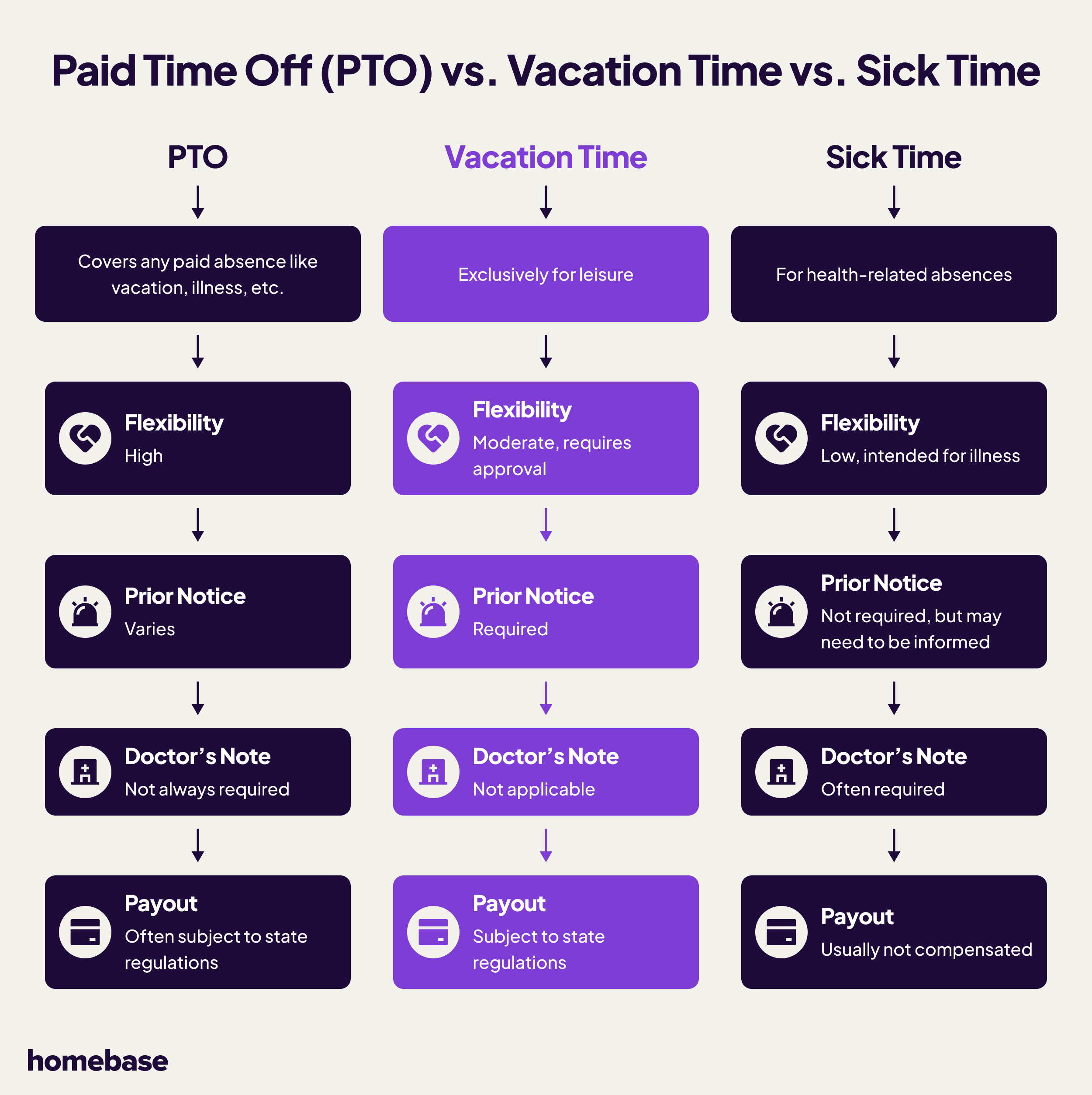If you’re looking to offer paid time off (PTO) to your employees either to comply with state law or to simply provide it as a benefit to your team, you might have some questions about sick time vs. vacation time and what the difference is between the two—if there is a difference at all.
The truth is that in today’s modern workforce, many business owners and HR professionals have decided to forgo the traditional PTO plans of separating sick days and vacation days and instead offer a general PTO bank for employees to use when they need time away from work, no matter the reason.
Still, it’s important for you to know the difference between a paid vacation and paid sick leave so you can make the decision on what kind of personal time plan works best for your business and your employees.
What is PTO?
PTO stands for “paid time off” and refers to any time an employee is being paid while they are away from work. This can include things like paid vacation or maternity leave.
Understanding Paid Time Off Versus Vacation and Sick Time
When offering benefits like paid time off (PTO) to employees, understanding the distinctions between PTO, vacation time, and sick time is essential for effective policy implementation.
- Paid Time Off (PTO): This term broadly covers any paid absence from work. It includes various reasons such as vacation, illness, and personal days, providing employees with the flexibility to use their leave as needed.
- Vacation Time: This is a specific category within PTO, designated exclusively for leisure and relaxation. Employees typically plan and schedule vacation time in advance.
- Sick Time: This leave is reserved for health-related absences, either for the employee’s illness or to care for a sick family member. It’s often used with little to no prior notice and might require a doctor’s note.
PTO vs. Vacation Time
Generally speaking, paid time off includes vacation time. Vacation time refers to an employee taking time off work for the purpose of taking a break, while PTO can be taken for different reasons, including vacation, jury duty, maternity leave, or illness.
- PTO is more flexible than vacation time, allowing employees to use their leave for a variety of reasons beyond just vacations.
- Vacation time, being a subset of PTO, is intended specifically for leisure and requires prior planning and approval.
- Regarding unused leave, both unused PTO and vacation time may be subject to payout upon an employee’s departure, depending on state regulations.
Comparing PTO and Sick Time
- PTO encompasses various types of leave, including sick time, whereas sick time is solely for health-related absences.
- Sick time, unlike PTO, may require a doctor’s note and is generally less flexible in terms of use.
- In terms of payout policies, unused sick time usually does not require compensation upon an employee’s exit, unlike PTO.
3 Key Differences Between Vacation Time vs. Sick Time
In terms of offering vacation vs. sick time, the difference between these two types of leave policies is pretty easy to understand. Sick leave refers to personal days the employees can use to either care for their own health or, in some cases, to care for a family member who is sick.

Employees use Vacation PTO days for—you guessed it—vacations, whether it’s a family trip or just a day the employee wants to enjoy a little “me” time by relaxing or having some fun.
There are, however, laws in many states that have a stricter definition of the two, requiring employers to follow certain rules:
1. Time-off Limitations
Employers have the right to set company policies around vacation time, including denying a vacation day or setting policies around when employees can use the vacation time. Employees can, however, take sick leave whenever they need to, regardless of the employer’s policies.
2. Time-off Reasons
In terms of sick days, employers can implement a policy that requires employees to submit a doctor’s note to ensure they took the sick day for an appropriate reason.
However, as long as they are following any implemented policies, employees can use their accrued vacation days when they wish, even if they run out of sick days and need to use their vacation time to make up for it.
3. Unused PTO Payout
Many states require employers to pay full-time employees for any unused vacation days at the end of the year or when they end their employment with the business. However, in most states, you do not need to pay out sick leave to terminated employees or when an employee leaves on their own terms.
Offering a PTO Bank
You also have the option of implementing a PTO policy and vacation policy that lumps all the personal days together instead of separating them out. Typically, businesses will dole out the personal hours to their employees over time, for example, the hours will be added to their bank each pay period.
A typical US employer that operates on the traditional PTO system gives employees 10 paid holidays (like the Fourth of July, New Year’s, etc.), 2 personal days, 2 weeks of vacation time, and 8 sick leave days per year.
If you offered the same amount of days but did not specify how many days can be used for each category, you would offer 20 days of PTO for the year on top of any holidays your business recognizes.
Here are a couple of examples:
- If you run a bi-weekly pay schedule with 26 paydays a year, your employee would be credited 1.3 PTO days each time they receive their paycheck every 2 weeks.
- With a semi-monthly pay schedule on the 1st and 15th of every month, employees would accrue 1.25 days of PTO for each of the 24 pay periods.
Understanding PTO & Sick Leave in 2024: Trends, Legislation, & Worker Preferences
In the U.S., if you work in the private sector, you’re likely to get around 10 days of paid time off (PTO) a year after working for a year. Even though people have PTO, more than half didn’t use all their days off in 2018. There’s a lot of interest in unlimited PTO — 70% of workers like the idea, but barely any companies, only 4%, actually offer it. People take PTO for many reasons, including to look after their mental health, with half of the people taking time off doing it for this reason.
Now, when it comes to sick leave, 77% of workers had paid sick leave in 2022. This changes depending on where you work. For instance, California’s planning to give workers up to 40 hours of sick leave right at the start of the year by 2024. Also, there’s been a noticeable increase in PTO requests globally, hitting a four-year high in January 2024, showing people are prioritizing time off more than before.
On a bigger scale, New York’s improving its Paid Family Leave, offering up to 12 weeks with pay for family and medical reasons. The pay can reach up to 67% of what you usually earn weekly. Other states like Colorado, Maryland, Delaware, and Maine are also setting up or broadening their Paid Family and Medical Leave programs, funded through payroll cuts, to help workers during important life events.
Crafting a Tailored PTO Strategy
Deciding on the most fitting PTO policy demands a careful balance between flexibility and structure.
A tailored approach, sensitive to both the operational dynamics of the organization and the diverse needs of its workforce, emerges as a cornerstone for cultivating a positive and productive work environment.
This customization extends beyond merely offering time off; it involves crafting a policy that reflects the values and operational realities of the business, ensuring both employee satisfaction and organizational efficiency.
Which PTO Plan is Best?
There are pros and cons to both PTO strategies, so you’ll have to decide what you think is best for your business based on the provided information.
Employees Prefer PTO Banks
Employees are typically more attracted to a company that offers a general, flexible PTO plan, especially if they don’t get sick often and can opt to use the days for vacation and personal time. This increases the number of days they can take off for fun reasons, and it doesn’t cost the employer any extra money.
However, You’ll Have to Pay Out More
Since the general PTO bank doesn’t specify between available sick and vacation days, employers in the states that require you to pay a terminated employee for the leftover sick time might have to pay more in leftover PTO.
Managing a PTO Plan
Whatever you decide in terms of your PTO policy, follow these tips to ensure a smoothly running plan:
- Make sure the paid time off policy suits the nature and culture of your business. A more flexible plan tends to work better with a business that is flexible enough to handle it.
- Lay out your policies. If your employees need to request paid leave in advance, but not if there is an emergency, make sure they know what counts as an emergency. You also need to let them know if there are any certain dates where you discourage using vacation days.
- If an employee is coming into work sick because they don’t want to take PTO, make them take the day off in order to protect the rest of your team and business.
Homebase payroll can help you manage your team’s PTO and pay them accordingly. When you run payroll, Homebase calculates taxes and paychecks, sends direct deposits to your team, and automatically pays and files your payroll taxes. Plus, your employees get on-demand access to their pay stubs, W-2s, and 1099s in the Homebase app.

